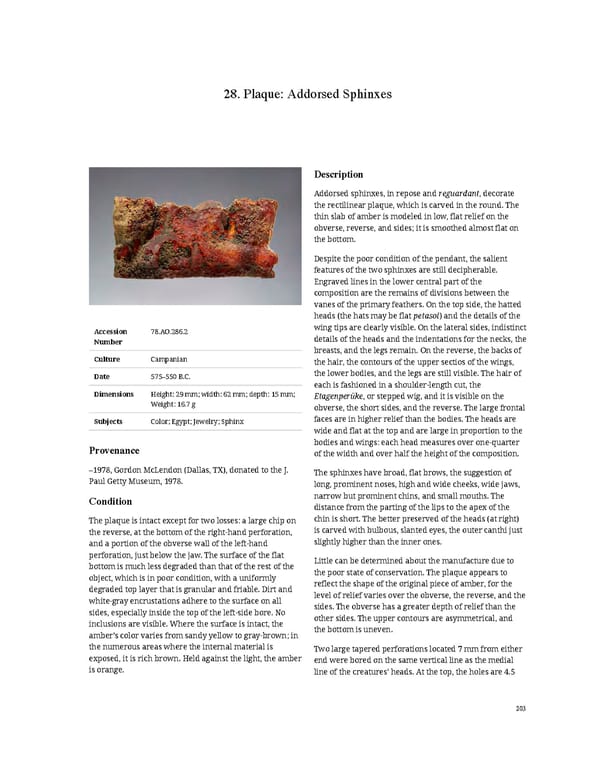28. Plaque: Addorsed Sphinxes Description Addorsed sphinxes, in repose and reguardant, decorate the rectilinear plaque, which is carved in the round. The thin slab of amber is modeled in low, flat relief on the obverse, reverse, and sides; it is smoothed almost flat on the bottom. Despite the poor condition of the pendant, the salient features of the two sphinxes are still decipherable. Engraved lines in the lower central part of the composition are the remains of divisions between the vanes of the primary feathers. On the top side, the hatted heads (the hats may be flat petasoi) and the details of the Accession 78.AO.286.2 wing tips are clearly visible. On the lateral sides, indistinct Number details of the heads and the indentations for the necks, the breasts, and the legs remain. On the reverse, the backs of Culture Campanian the hair, the contours of the upper sectios of the wings, Date 575–550 B.C. the lower bodies, and the legs are still visible. The hair of each is fashioned in a shoulder-length cut, the Dimensions Height: 29 mm; width: 62 mm; depth: 15 mm; Etagenperüke, or stepped wig, and it is visible on the Weight: 16.7 g obverse, the short sides, and the reverse. The large frontal Subjects Color; Egypt; Jewelry; Sphinx faces are in higher relief than the bodies. The heads are wide and flat at the top and are large in proportion to the Provenance bodies and wings: each head measures over one-quarter of the width and over half the height of the composition. –1978, Gordon McLendon (Dallas, TX), donated to the J. The sphinxes have broad, flat brows, the suggestion of Paul Getty Museum, 1978. long, prominent noses, high and wide cheeks, wide jaws, Condition narrow but prominent chins, and small mouths. The distance from the parting of the lips to the apex of the The plaque is intact except for two losses: a large chip on chin is short. The better preserved of the heads (at right) the reverse, at the bottom of the right-hand perforation, is carved with bulbous, slanted eyes, the outer canthi just and a portion of the obverse wall of the left-hand slightly higher than the inner ones. perforation, just below the jaw. The surface of the flat Little can be determined about the manufacture due to bottom is much less degraded than that of the rest of the the poor state of conservation. The plaque appears to object, which is in poor condition, with a uniformly reflect the shape of the original piece of amber, for the degraded top layer that is granular and friable. Dirt and level of relief varies over the obverse, the reverse, and the white-gray encrustations adhere to the surface on all sides. The obverse has a greater depth of relief than the sides, especially inside the top of the left-side bore. No other sides. The upper contours are asymmetrical, and inclusions are visible. Where the surface is intact, the the bottom is uneven. amber’s color varies from sandy yellow to gray-brown; in the numerous areas where the internal material is Two large tapered perforations located 7 mm from either exposed, it is rich brown. Held against the light, the amber end were bored on the same vertical line as the medial is orange. line of the creatures’ heads. At the top, the holes are 4.5 203
 Ancient Carved Ambers in the J. Paul Getty Museum Page 212 Page 214
Ancient Carved Ambers in the J. Paul Getty Museum Page 212 Page 214